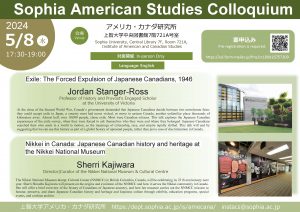| Date | May 8, 2024(Wed.)17:30-19:00 |
|
|---|---|---|
| Venue | Room L-721, 7th floor, Central Library, Yotsuya Campus, Sophia University *Visitors from outside the university are kindly asked to register at the library entrance. |
|
| For | Graduate students and faculties | |
| Language | English |
|
| Registration | ▸Pre-registration is required |
|
| Title:Exile: The Forced Expulsion of Japanese Canadians, 1946 Lecturer:Jordan Stanger-Ross (Professor of history and Provost’s Engaged Scholar at the University of Victoria) At the close of the Second World War, Canada’s government demanded that Japanese Canadians decide between two unwelcome fates: they could accept exile to Japan, a country most had never visited, or move to eastern Canada, another unfamiliar place thousands of kilometers away. Almost half, over 10,000 people, chose exile. Most were Canadian citizens. This talk explores the Japanese Canadian experiences of the exile survey, when they were forced to ask themselves who they were and where they belonged. Japanese Canadians searched their own souls in a world in motion, as the meanings of citizenship, race, and empire rapidly shifted. This talk will end by suggesting that we can see this history as part of a global history of uprooted people, rather than just a case of discrimination in Canada. |
||
| Title:Nikkei in Canada: Japanese Canadian history and heritage at the Nikkei National Museum Lecturer:Sherri Kajiwara (Director|Curator of the Nikkei National Museum & Cultural Centre) The Nikkei National Museum & Cultural Center (NNMCC) in British Columbia, Canada, will be celebrating its 25 th anniversary next year. Sherri Shinobu Kajiwara will present on the origins and evolution of the NNMCC and how it serves the Nikkei community in Canada. She will offer a brief overview of the history of Canadians of Japanese ancestry, and how her museum carries out the NNMCC mission to honour, preserve, and share Japanese Canadian history and heritage and Japanese culture through exhibits, education programs, special events, and a robust archive. |
||
 |
||